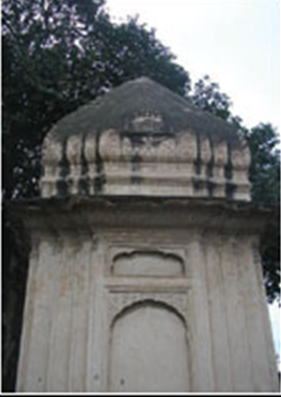Gor Khatri
This is a collection of articles archived for the excellence of their content. Readers will be able to edit existing articles and post new articles directly |
Gor Khatri
Gor Khatri Comple
A witness to several civilisations, the Gor Khatri is still carrying traces of history that makes it a place worth conserving, writes Sher Alam Shinwari
Gor Khatri Complex, a fortified square compound, spread over an area of 25600 sq metres, is located on the highest point of Peshawar. The historical profile of the city which dates back to third century BC, makes it one of the oldest existing cities of South Asia.
The Huns and Sassainian’s invasions of Gor Khatri — which, in Sanskrit mean ‘warrior’s grave’ — were followed by the arrival of Hindus who used to perform the ritual of Sardukahr (shaving heads) of pilgrims. The present complex was built by Jahan Ara Begum, daughter of Mughal Emperor Shah Jahan, in 1641.
It is a typical Mughal sarai (guesthouse). She renamed it as ‘Sarai Jahanabad’, constructed a mosque and had wells dug up with stairways inside them, allowing people coming from long distance to either sip or fill pitchers. The compound used to serve as safety inn for camel caravans laden with merchandise.
There are two main gates on its western and eastern sides — each with double-storied pavilion, while 25 arched cells made of brick and lime on the southern, 14 on the western, 13 on the northern and eight on the eastern sides give a fascinating look to the overall look of the complex. A site also worth noticing in south-eastern portion is the barracks — probably made in the British era.
Unfortunately, the Sikh ruler destroyed the mosque and constructed a Gorkshanath temple at the southern part of the compound for Shiva, which still exits, with a big tree nearby called ‘bodhi’ — considered to be sacred to most — and there is a 10-room apartment in dilapidated condition adjacent to it.
The Kanishka stupa is of immense importance, and goes way back in history. For instance, in AD630 Chinese pilgrim Hiuen T’sang visited Peshawar and paid tributes to the Kanishka stupa, while Zahiruddin Babar had also mentioned Gor Khatri in his memoirs. From 1838 to 1845, Paolo de Avitabile, an Italian mercenary and governor of Peshawar, resided here and held court in the compound. Furthermore, Gertrude Bell, a celebrated English archaeologist, visited Gor Khatri in 1903 and described its historical importance.
Later, the British Municipal Committee Peshawar housed a fire brigade station on the left eastern part. Later on the city police station and revenue office were also set up there.
The first vertical excavations were carried out in 1992-93 and 1995-96. The third excavation project was launched in 2003 till 2007. The network of cells has been renovated but some work is still in progress. In March 2002, it was developed into a recreational facility for children and families in which, several grilled patches of green lawns were laid out in Mughal style. A mosque on northern part has also been built.
However, a setback to this historic site was witnessed when a grand wedding hall was allowed to be built inside the Gor Khatri precincts, despite public uproar. However, the provincial department of archaeology and museums intends to convert the site into a city museum once the excavation and renovation projects are completed.
